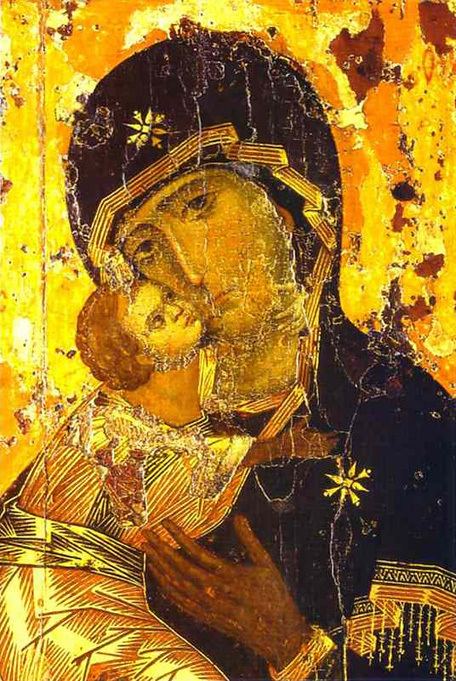 | ||
A palladium or palladion is an image or other object of great antiquity on which the safety of a city or nation is said to depend. The word is a generalization from the name of the original Trojan Palladium, a wooden statue (xoanon) of Pallas Athena that Odysseus and Diomedes stole from the citadel of Troy and which was supposedly later taken to the future site of Rome by Aeneas, where it remained until perhaps transferred to Constantinople and lost sight of after the conversion of the Empire to Christianity.
Contents
In English, since around 1600, the word "palladium" has been used figuratively to mean anything believed to provide protection or safety, and in particular in Christian contexts a sacred relic or icon believed to have a protective role in military contexts for a whole city, people or nation. Such beliefs first become prominent in the Eastern church in the period after the reign of the Byzantine Emperor Justinian I, and later spread to the Western church. Palladia were processed around the walls of besieged cities and sometimes carried into battle. In this more offensive role they may also be referred to as "vexilla" (singular vexillum, Latin for "battle standard").
Troy and Rome
The original Palladion was part of the foundation myths of both Troy and Rome. It was a wooden image of Pallas (whom the Greeks identified with Athena and the Romans with Minerva) said to have fallen from heaven in answer to the prayer of Ilus, the founder of Troy. In the Trojan War the besieging Greeks discovered that they would be unable to take the city while it was protected by it, and so Odysseus and Diomedes stole it from the citadel of Troy before taking the city by the ruse of the Trojan Horse. According to a later set of myths it was then taken to Rome, where an actual image, unlikely to have been actually of Trojan origin, was kept in the Temple of Vesta in the Roman Forum for centuries, and regarded as one of the pignora imperii, sacred tokens or pledges of Roman rule (imperium). The Roman story is related in Virgil's Aeneid and other works.
Athens
The goddess Athena was worshipped on the Acropolis of Athens under many names and cults, the most illustrious of which was of the Athena Poliás, "[protectress] of the city". The cult image of the Poliás was a wooden effigy, often referred to as the "xóanon diipetés" (the "carving that fell from heaven"), made of olive wood and housed in the east-facing wing of the Erechtheum temple in the classical era. Considered not a man-made artefact but of divine provenance, it was the holiest image of the goddess and was accorded the highest respect. It was placed under a bronze likeness of a palm tree and a gold lamp burned in front of it. The centerpiece of the grand feast of the Panathenaea was the replacement of this statue's woolen veil with a newly woven one. It was also carried to the sea by the priestesses and ceremonially washed once a year, in the feast called the Plynteria ("washings"). Its presence was last mentioned by the Church Father Tertullian (Apologeticus 16.6), who, in the late 2nd century AD, described it derisively as being nothing but "a rough stake, a shapeless piece of wood" (Latin original: "[] Pallas Attica [] quae sine effigie rudi palo et informi ligno prostat?"). Earlier descriptions of the statue have not survived.
Christian palladia
Around the end of the 6th century the first references to Christian palladia start to appear. The Image of Edessa in Armenian Mesopotamia, or Mandylion, later moved to Constantinople, is one of the first and long the most famous examples. This was later credited with the failure of the Persian siege of Edessa in 544. But the image is not mentioned in the account of Procopius, writing soon after the event, and first appears as the agent of the failure in the history of Evagrius Scholasticus of about 593. Specific icons, especially those of the Virgin Mary or Virgin and Child became credited with specialist functions, with their veneration aiding against disease or other misfortunes, and the military role of palladium was an example of this.
Beliefs attributing particular icons as palladia were found especially in the Eastern church, and have remained particularly powerful in Russian Orthodoxy, where a number of icons protected different cities. In Celtic Christianity palladia were more often relics, which in the Celtic tradition were typically possessions of a saint, such as books, bells, belts and croziers, all housed in reliquaries, and in Irish circumstances functioned as the battle standards of clans rather than protecting a city. They were sometimes carried into battle in their reliquaries or cumdach, hanging by a chain around the neck of a member of the clan. In the Western church such beliefs have declined even in Catholic countries since the Reformation, and disappeared in Protestant beliefs. Various folk myths have instead arisen, but these are probably not regarded very seriously even by the general public.
The Byzantine palladia, which first appear in the late 6th century, cannot be said to have had a very successful track record, as apart from Constantinople most major cities in Egypt, Syria and later Anatolia fell to Muslim attacks. Just before the start of the Byzantine Iconoclasm an incident of what might be called a "reverse-palladium" is recorded. According to Iconoclast sources an officer called Constantine, defending Nicaea against an Arab siege in 727, smashed an icon of the Virgin, and this saved the city. The Iconodule sources also record the incident, but say that Constantine was promptly killed, and the city saved by other icons, including the famous series of 318 portraits of participants in the First Council of Nicaea which adorned the hall where the council had met in 325.
